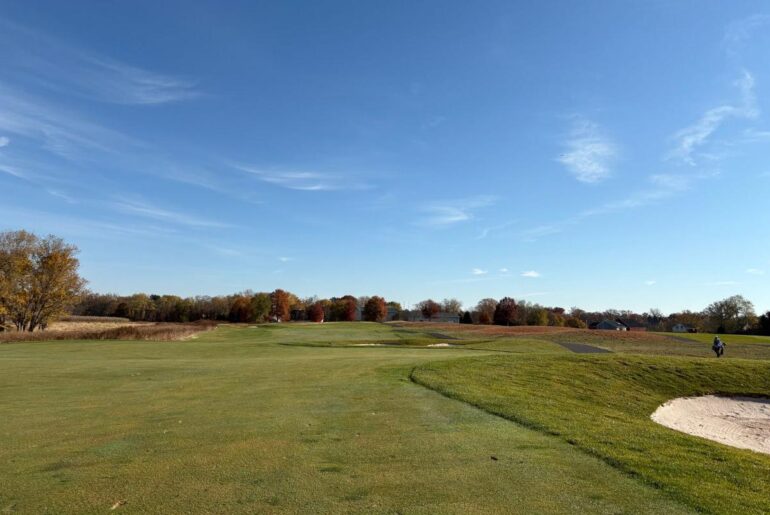Every Golf Course Explained: From Beer Leagues to Bentgrass Elites
Municipal courses. Let’s start with the people’s course, the municipal golf course, or MUN as we call it. This is where golf dreams go to get humbled by reality. Municipal courses are owned by your city or county, which means they’re funded by taxpayers and managed by people who probably think a sand wedge is something you eat at the beach. The good news, green fees that won’t require a second mortgage. The bad news, everything else. Don’t get me wrong, Munis serve a purpose. They’re the democracy of golf. CEOs play next to construction workers. Retirees mix with college kids. And everyone’s united by one thing, complaining about the greens. The conditions at Munis are, let’s call them, rustic. The fairways have more bare spots than a middle-aged man’s scalp. The greens roll about as true as a politician’s promise. And the sand traps, they’re less bunker and more kitty litter box that hasn’t been cleaned in months. But here’s the thing about munas. They’re where you learn to play real golf. When you can make par on a green that looks like it was mowed by a drunk guy on a riding mower, you can play anywhere. It’s like learning to drive in a beat up pickup truck. Sure, it’s not pretty, but it builds character. The pace of play at Munis is slower than a DMV line. 5-hour rounds are standard because nobody wants to let faster groups play through. It’s not malicious. It’s just that Uncle Bob paid his 35 bucks and he’s going to get his money’s worth even if it takes until sunset. Country clubs. Now, let’s talk about the other end of the spectrum. Country clubs. This is where golf meets social climbing, and your handicap matters less than your bank account. Country clubs aren’t just golf courses. They’re exclusive societies with grass. The initiation fees alone could buy you a decent house in most of America. We’re talking $50,000 just to join, plus monthly dues that would make your car payment look like pocket chain. But man, the conditions are incredible. The fairways are so perfect, they look like green carpets. The Greens roll truer than a Swiss watch. Every blade of grass is manicured like it’s going to a job interview. They have more groundskeepers than some small towns have residents. The clubhouse is where the real action happens. This isn’t just a pro shop and a snack bar. We’re talking full restaurants, bars, swimming pools, tennis courts, and dining rooms where deals get made over 18-year-old scotch. The locker rooms have attendants who know your name, your drink preference, and probably your wife’s birthday. The dress code is stricter than a military academy. Collared shirts tucked in, no denim, proper golf shoes only. Show up in cargo shorts and a tank top and security will escort you out faster than you can say dress code violation. Playing at a country club is like being in a golf commercial. Everything’s perfect. Everyone’s polite and the only sounds you hear are the gentle thack of well struck balls and the quiet murmur of business being conducted on the back nine. Quick pause here. If you’re enjoying this breakdown of golf social hierarchy, smash that subscribe button and drop a comment below telling me about the weirdest golf course you’ve ever played. Trust me, I’ve got stories and I want to hear yours, too. Resort courses. Resort courses are golf’s version of vacation romance. Beautiful, expensive, and you’ll probably never see them again. These courses are built to impress. We’re talking dramatic elevation changes, water features that would make Disney jealous, and views so stunning you’ll forget you just chunked a seven iron into the lake. Resort courses are designed by famous architects with names you can’t pronounce, but price tags you definitely can. The conditions are usually pristine because the resort’s reputation depends on it. Tourists don’t come back to complain about bad greens. They just leave bad reviews on Trip Adviser and book somewhere else next year. But here’s the best part. Resort courses are typically designed for you to play a great round and want to come back on your next trip, inviting wide fairway and huge greens are a common element of these courses. The pace of play is all over the map. You’ve got serious golfers trying to enjoy a premium experience mixed with vacation hackers who think golf is just an excuse to drive the cart and drink beer. It’s like mixing Formula 1 drivers with people who just got their learner’s permit. Resort courses also come with resort prices. Green fees that would make your accountant weep, cart fees that cost more than some people’s entire golf budget, and pro shop prices that make airport food look reasonable. Lynx courses. Lynx courses are golf in its purest, most brutal form. This is where the game was invented, and mother nature is your biggest opponent. True Lynx courses are built on Lynx land, that strip of sandy, windswept terrain between the sea and arable land. Think Scotland, Ireland, and a few spots along the American coast. These courses don’t fight nature, they surrender to it completely. The conditions change by the hour. One minute you’re playing in calm conditions, the next you’re battling 40 mph winds that can turn a gentle wedge shot into a line drive to nowhere. The weather is part of the challenge, and checking the forecast becomes as important as checking your yardage book. Link’s courses are firm and fast. The ball bounces and rolls forever, which sounds great until you realize it rolls into every pot bunker, Gorse bush, and piece of rough within a threemile radius. You’ll hit shots that would be perfect on your home course and watch them bound into trouble you didn’t even know existed. The rough on Link’s courses isn’t just long grass. It’s like playing out of a hayfield. Find the wrong spot and you’re not just losing a stroke, you’re losing golf balls and possibly small children. But when the conditions are right and you’re playing well, Link’s Golf is pure magic. There’s something primal about battling the elements with nothing but your clubs and your wits. It’s golf the way it was meant to be played. Raw, natural, and completely unforgiving. Daily fee courses. Daily fee courses are the middle children of golf. Not fancy enough to be exclusive, not cheap enough to be munis, but trying their best to please everyone. These courses are privately owned but open to the public which means they have to balance making money with keeping conditions decent. It’s a tough spot to be in. Charge too much and people go to the MUN. Charge too little and you can’t maintain the course properly. The conditions at Daily Fees vary wildly. Some are hidden gems that rival country clubs at half the price. Others are barely a step up from your local goat track. It’s like online dating. The pictures look great, but you never know what you’re getting until you show up. Daily fee courses often try to punch above their weight class. They’ll have one signature hole that looks like it belongs at Pebble Beach, surrounded by 17 holes that look like they belong at your nephew’s miniature golf birthday party. The clientele is a mixed bag. You’ve got serious golfers looking for a good value, casual players who want something nicer than the MUN, and corporate groups who couldn’t get into the country club. It’s like a golf United Nations. and everyone’s trying to get along. Many daily fee courses offer loyalty programs, punch cards, and season passes to build a regular customer base. They’re fighting for every dollar against courses that are either cheaper or fancier, so customer service actually matters. Executive courses. Executive courses are golf’s version of a popular sitcom versus a feature film. These courses are shorter than regulation 18-hole courses, usually featuring mostly par 3s with a few short par 4s thrown in. The total yardage is typically under 4,000 yards, which means you can actually walk the course without needing oxygen. Executive courses are perfect for beginners, seniors, and anyone who wants to work on their short game without committing to a 5-hour death march. You can play a full round in under 3 hours, which leaves time for important things like having a life outside of golf. The conditions are usually decent because there’s less course to maintain. It’s easier to keep nine holes of mostly par 3es in good shape than 18 holes of championship length torture. Don’t let the shorter length fool you. Executive courses can still humble you. Those par 3s might be short, but they’re often target golf at its finest. Miss the green and you’re chipping from places that would make a mountain goat nervous. Executive courses are also great for working on specific parts of your game. Want to practice hitting wedges and short irons? This is your place. Need to work on putting without the pressure of a 4-hour round? Perfect. Nine-hole courses. Nine-hole courses are golf’s perfect compromise. Quick, satisfying, and slot easily into a busy schedule. They are not just watered down options. They are fulllength layouts that condense the challenge of 18 holes into half the time in space. With only nine holes, every shot matters more, amplifying the strategic pressure. The core appeal is efficiency. You can play a legitimate round in about 2 and 1/2 hours, making it possible before work, during lunch, or after dinner. It’s ideal for addicts who can’t spare an entire day. Since designers have only nine chances to impress, these courses often have more character per hole, featuring quirky layouts and creative use of terrain that sticks in your memory. Because there’s less ground to cover, maintenance resources go further, resulting in excellent course conditions. It’s easier to keep nine holes pristine than to spread resources across 18. The greens, fairways, and even the rough often benefit. The clientele is often a blend of locals, retirees, busy professionals, and families introducing kids to the game. They’ve all figured out the secret. You don’t need 18 holes for a great experience. Pace of play is generally excellent due to the collective goal of an efficient round. Many courses also offer the option to play 18 by using different TE’s for the second nine, giving you a fresh challenge. Nine-hole golf is also fantastic for working on your game. You can loop the course multiple times, testing new clubs and strategies in real playing conditions. The only risk after enjoying the joy of a quick nine 18 holes may start to feel like an unnecessary marathon. Semi-private courses. Semi-private courses are trying to have it both ways. the exclusivity of a private club with the revenue stream of public play. It’s like being sort of pregnant. Theoretically possible, practically complicated. These courses have members who pay annual fees and get preferred tea times, but they also accept public play to help pay the bills. It’s a delicate balance that works about as well as you’d expect. Members get the perks, better tea times, discounted rates, access to member events, and the right to complain about all those public players messing up their course. Public players get access to nicer conditions than most daily fee courses, but they’re always secondass citizens. The conditions at semi-private courses are usually quite good because they need to keep the members happy while attracting public play. It’s like having two different customer bases with two different expectations and somehow making both groups satisfied. The clubhouse amenities fall somewhere between a daily fee course and a full private club. You might get a decent restaurant and bar, but don’t expect towel service in the locker room. Semi-private courses often struggle with identity. Are they exclusive or accessible? Premium or affordable? The answer is usually sort of both, which satisfies nobody completely, but keeps the lights on. Military/base courses. Military golf courses are where Uncle Sam meets the tea box, providing affordable golf primarily for active duty personnel, veterans, and their families. Thanks to taxpayer subsidies, the green fees are incredibly low. Often just $ 20 to $30 for 18 holes, cart included. It’s an accessible perk our service members have certainly earned. The course conditions are variable. They range from surprisingly well-maintained gems, if the base commander is a golf enthusiast, to layouts where the rough truly lives up to its name. Maintenance quality hinges entirely on the base’s budget and priorities. Pace of play is distinct because military golfers treat the game like a mission. They show up on time and play efficiently. A 4-hour round is considered slow, and there’s none of the drawn out ritual of rehearsing every shot. It’s a refreshingly brisk experience. The clientele is polite, rule- abiding, and tight-knit, consisting of active duty members, retirees, and families. The 19th whole conversations are legendary. Where else can you swap war stories while critiquing your short game? These courses often feature quirky layouts dictated by existing base infrastructure. Don’t be surprised to find a fairway running alongside a runway or a green within earshot of artillery practice. Nothing test focus quite like a howitzer in the distance. The pro shops are no frrills, selling the basics at reasonable prices, reflecting the community focused nature of golf on base. University courses. University golf courses are unique hybrids serving as practice facilities for college teams, recreational outlets for students and faculty, and revenue generators for the athletic department. They juggle the roles of highle training grounds and public links, creating interesting dynamics. Course conditions vary dramatically based on the school’s investment. Elite programs like Stanford or Duke boast courses that rival private clubs, essential for competitive recruiting. Smaller schools, however, might feature layouts maintained with a more modest utilitarian approach. The clientele is diverse. Student golfers receive heavily discounted rates, leading to a wide spectrum of skill from the scratch players on the team to complete beginners. This mix is inherently educational. Faculty and staff often enjoy membership privileges, creating a distinct social dynamic where a philosophy professor might debate a business student on the rules of golf. University courses often host college tournaments, which periodically transforms the layout. The conditions are intentionally ramped up. The rough grows longer, and pin positions become trickier, turning a familiar course into a serious championship test. Consequently, pace of play can be frustrating. Serious golfers are mixed with students happy to be outside instead of studying. Some groups treat the round competitively, while others treat it like a mobile party. It’s a classic collegiate blend of high competition and laid-back recreation. Championship courses. Championship courses are where golf gets serious. These are the tracks that host professional tournaments, and they’re designed to separate the contenders from the pretenders. Everything about championship courses is turned up to 11. The rough is thicker, the greens are faster, the bunkers are deeper, and the water hazards are positioned exactly where you don’t want them to be. These courses don’t just test your golf game. They perform psychological evaluations. The length is intimidating. We’re talking 7,000 plus yards from the tips, which means even your good drives leave you with long irons into greens that are harder to hit than a lottery jackpot. The course setup changes daily with pin positions that would make a satist proud. Playing a championship course is like taking a final exam you didn’t study for. Every hole presents multiple ways to make big numbers, and the margin for error is smaller than your patience after a three putt. But here’s the thing. Championship courses are also incredibly fair. Every hazard is visible. Every challenge is honest. And if you play smart golf, you can score. They reward good shots and punish bad ones, which is exactly what golf should do. The conditions are usually immaculate because these courses have the budget and expertise to maintain perfection. The greens roll like glass, the fairways are striped like a baseball field, and even the rough looks good. So, there you have it. every type of golf course explained. From the democratic chaos of municipal courses to the manicured perfection of championship tracks, each one offers a different flavor of the beautiful torture we call golf. The truth is, every course teaches you something different. Munis teach you to adapt and overcome. Country clubs show you what’s possible with unlimited resources. Links courses remind you that golf is a game played outdoors. and championship courses prove that even the best players in the world struggle with this impossible game. No matter where you play, remember this. Golf is hard everywhere. The grass might be greener at the country club, but your slice is still going to find the trees. So, pick a course that fits your budget and your ego. And go make some memories. If this helped you understand the wild world of golf courses, hit subscribe and tell me in the comments which type of course humbled you the
Please Subscribe To The Channel and Join Us For Future Videos!
Every Golf Course Explained: From Beer Leagues to Bentgrass Elites
#lpga #golf #pga #livgolf








7 Comments
ALL TRUE
Ai slop
Love it
Mooniss
This is garbage. Just a waste of time. Hard NO.
I’ve played all types but the last 3 and a true links course, though I’ve played a “links style” course.
You forgot the retirement community course, lined with 55+ housing, but open to the public, usually 5000ish yards from the whites. And HOA courses, similar to the retirement community, but no age limit on the home buyers.
Our Muni's in NYS our top notch.